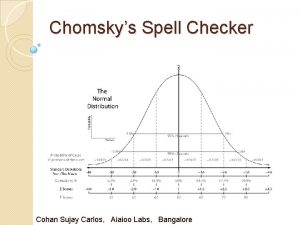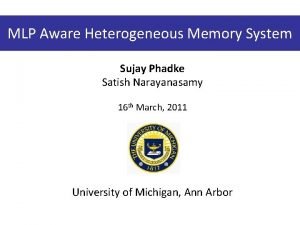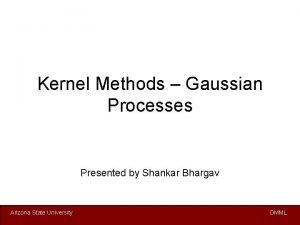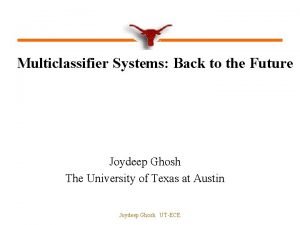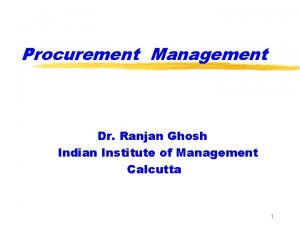Dr Sujay Ghosh Political Science Second Semester PLS203

























- Slides: 25

Dr Sujay Ghosh Political Science Second Semester PLS-203 A

Topic 3 Rural Society and Agrarian Changes

Keywords • • • Rural society in pre-Modern India Rural society in British India Rural society in independent India Social changes in rural India Land Reforms Green Revolution

Rural Society in India 1 • In ancient and medieval times, rural India had a very closed life: hardly any connection with the outside world. • Land was the community property: no private ownership

Rural Society in India 2 • During ancient and medieval period, the relationship between the rulers and village community was only tax collection. People did not bother who was the ruler

Rural Society in India: British Period • With British rule, there was a fundamental structural shift, as capitalist system was introduced in the land relations

Rural Society in India: British Period • The forces of colonial capitalism entered the interior of rural India. • Rural society became integrated with the British rule

Rural Society in India: British Period • Subsequently, this also paved way for the nationalist leadership to reach the interior of the country. • The spread of literacy & modern means of communication facilitated the process

Rural Society after Independence • Massive social and political mobilisation occurred in rural India during the freedom struggle phase • Rural India played definite role in India’s struggle for independence

Agrarian Change in Contemporary India • We have seen the historical background of rural India • Agrarian change has to be seen in this backghround

Importance of Agriculture • Agriculture, we know is the backbone of rural economy and society • Land is the marker of power and prestige

Social Changes in Rural India • Social conflicts in rural India have gathered around land caste • Caste has been used to reinforce the existing power relations in rural India

Social Changes in Rural India • caste and land therefore, were the epicentres of social conflict and change in rural India • Agrarian conflicts has to be seen in this context

Agrarian Changes • Conflicts on agriculture were the motivators for agrarian changes • Agrarian conflicts occurred during medieval and British period as well • Mahatma Gandhi’s struggle in India started with Bardoli Satyagraha, around agrarian issues

Agrarian changes in the 1960 s • In independent India, Agrarian conflcits & changes started occurring in the 1960 s • Then it became all-India issues

1960 s • Two particular issues must be remembered – they have erupted in the 1960 s • One, violent Maoist movement, known as Naxalite movement. It started in West Bengal, but spread over to many parts of the country • Two, the Green Revolution

Naxalite Movement • This movement, started with the demand for better wages for agricultural workers in the village of Naxalbari, West Bengal • It was against the landowners • Ultimately, the movement snowballed into a major revolt against the Indian state as it had spread into many regions • Even today, some parts of India are afflicted by violent agrarian conflicts

The Green Revolution • Agricultural production multiplied in India, thanks to the Green Revolution • This created a rich peasantry who wanted to benefit from the market forces • That also changed the socio-economic relation in the villages

Green Revolution: Downsides • Landlords operated on the basis of ruthless profit-and-loss • Instead of sharecroppers, agricultural labourers were hired • However, such market logic did not increase the bargaining power of the labourers. They were still ties with the bindings of caste

The 1970 s • Aftermath the Naxalite movement, demands for Land Reforms had grown • Although conceived by Nehru, it did not advance much • The Left Front government in West Bengal, had Land Reforms as its electoral agenda • They implemented it after 1977 electoral victory • As an institutional infrastructure, they started Panchayati Raj Institutions (PRIs) – rural local governments

The 1980 s • Many other states started implementing Land Reforms since the 1980 s • The result was mixed – not as successful as West Bengal • However, the importance of PRIs was stressed

The 1990 s • The historic 73 rd Amendment was passed in 1992 – PRIs became mandatory • PRIs were also empowered to implement various development programmes in the villages

Beyond 1990 s • The 73 rd Amendment had contributed to significant democratisation of rural India • At the same time, due to increase of population, land was fragmented • As a result, the large landowning ommunities faced disintegration • Alongside, agricultural labour became quite assertive & organised in rural India

The Current Situation • Urban space is gradually increasing • Many people in rural India are losing interest in agriculture • Significant migration to urban India • Growth of rural based industries • All these are leading to strain in the agricultural sector, already afflicted by everrising input costs

Conclusion: Agriculture is the basis of our civilisation
 Cohan sujay carlos
Cohan sujay carlos Sujay jayakar
Sujay jayakar Mlp
Mlp Sujay shankar
Sujay shankar Sujay jayakar
Sujay jayakar Sujay jayakar
Sujay jayakar What is the answer
What is the answer Programming in c pradip dey & manas ghosh
Programming in c pradip dey & manas ghosh Prodipto ghosh
Prodipto ghosh Dr ranjan ghosh
Dr ranjan ghosh Kashiprasad ghosh
Kashiprasad ghosh Senhive
Senhive Urmi ghosh-dastidar
Urmi ghosh-dastidar Ghosheo
Ghosheo Advocate prodipto ghosh
Advocate prodipto ghosh Shibani ghosh
Shibani ghosh Pradip dey and manas ghosh programming in c
Pradip dey and manas ghosh programming in c Dr ranjan ghosh
Dr ranjan ghosh My favourite subject
My favourite subject Environmental science defination
Environmental science defination Earth science semester 2 final exam answers
Earth science semester 2 final exam answers 186 282 miles per second into meters per second
186 282 miles per second into meters per second Uml political science
Uml political science Cyrus masroori
Cyrus masroori Difference between sociology and other social sciences pdf
Difference between sociology and other social sciences pdf Relation of social work with other social sciences
Relation of social work with other social sciences
